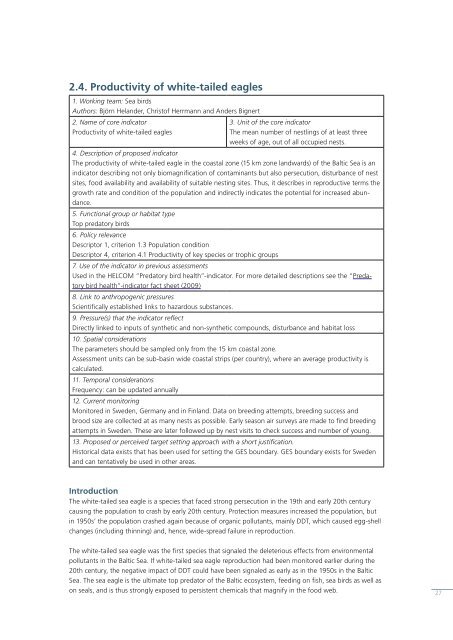Interim report of the HELCOM CORESET project
Interim report of the HELCOM CORESET project
Interim report of the HELCOM CORESET project
Create successful ePaper yourself
Turn your PDF publications into a flip-book with our unique Google optimized e-Paper software.
2.4. Productivity <strong>of</strong> white-tailed eagles<br />
1. Working team: Sea birds<br />
Authors: Björn Helander, Christ<strong>of</strong> Herrmann and Anders Bignert<br />
2. Name <strong>of</strong> core indicator<br />
Productivity <strong>of</strong> white-tailed eagles<br />
3. Unit <strong>of</strong> <strong>the</strong> core indicator<br />
The mean number <strong>of</strong> nestlings <strong>of</strong> at least three<br />
weeks <strong>of</strong> age, out <strong>of</strong> all occupied nests.<br />
4. Description <strong>of</strong> proposed indicator<br />
The productivity <strong>of</strong> white-tailed eagle in <strong>the</strong> coastal zone (15 km zone landwards) <strong>of</strong> <strong>the</strong> Baltic Sea is an<br />
indicator describing not only biomagnifi cation <strong>of</strong> contaminants but also persecution, disturbance <strong>of</strong> nest<br />
sites, food availability and availability <strong>of</strong> suitable nesting sites. Thus, it describes in reproductive terms <strong>the</strong><br />
growth rate and condition <strong>of</strong> <strong>the</strong> population and indirectly indicates <strong>the</strong> potential for increased abundance.<br />
5. Functional group or habitat type<br />
Top predatory birds<br />
6. Policy relevance<br />
Descriptor 1, criterion 1.3 Population condition<br />
Descriptor 4, criterion 4.1 Productivity <strong>of</strong> key species or trophic groups<br />
7. Use <strong>of</strong> <strong>the</strong> indicator in previous assessments<br />
Used in <strong>the</strong> <strong>HELCOM</strong> “Predatory bird health”-indicator. For more detailed descriptions see <strong>the</strong> “Predatory<br />
bird health”-indicator fact sheet (2009)<br />
8. Link to anthropogenic pressures<br />
Scientifi cally established links to hazardous substances.<br />
9. Pressure(s) that <strong>the</strong> indicator refl ect<br />
Directly linked to inputs <strong>of</strong> syn<strong>the</strong>tic and non-syn<strong>the</strong>tic compounds, disturbance and habitat loss<br />
10. Spatial considerations<br />
The parameters should be sampled only from <strong>the</strong> 15 km coastal zone.<br />
Assessment units can be sub-basin wide coastal strips (per country), where an average productivity is<br />
calculated.<br />
11. Temporal considerations<br />
Frequency: can be updated annually<br />
12. Current monitoring<br />
Monitored in Sweden, Germany and in Finland. Data on breeding attempts, breeding success and<br />
brood size are collected at as many nests as possible. Early season air surveys are made to fi nd breeding<br />
attempts in Sweden. These are later followed up by nest visits to check success and number <strong>of</strong> young.<br />
13. Proposed or perceived target setting approach with a short justifi cation.<br />
Historical data exists that has been used for setting <strong>the</strong> GES boundary. GES boundary exists for Sweden<br />
and can tentatively be used in o<strong>the</strong>r areas.<br />
Introduction<br />
The white-tailed sea eagle is a species that faced strong persecution in <strong>the</strong> 19th and early 20th century<br />
causing <strong>the</strong> population to crash by early 20th century. Protection measures increased <strong>the</strong> population, but<br />
in 1950s’ <strong>the</strong> population crashed again because <strong>of</strong> organic pollutants, mainly DDT, which caused egg-shell<br />
changes (including thinning) and, hence, wide-spread failure in reproduction.<br />
The white-tailed sea eagle was <strong>the</strong> fi rst species that signaled <strong>the</strong> deleterious effects from environmental<br />
pollutants in <strong>the</strong> Baltic Sea. If white-tailed sea eagle reproduction had been monitored earlier during <strong>the</strong><br />
20th century, <strong>the</strong> negative impact <strong>of</strong> DDT could have been signaled as early as in <strong>the</strong> 1950s in <strong>the</strong> Baltic<br />
Sea. The sea eagle is <strong>the</strong> ultimate top predator <strong>of</strong> <strong>the</strong> Baltic ecosystem, feeding on fi sh, sea birds as well as<br />
on seals, and is thus strongly exposed to persistent chemicals that magnify in <strong>the</strong> food web.<br />
27













